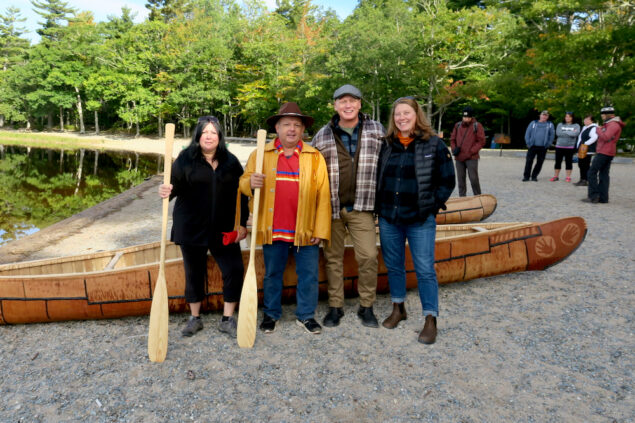This post is the result of an arms length collaboration with The Canadian Canoe Museum.
By Kim Gray
If you’re a canoe lover living in Canada, you might agree that one of the most exciting developments in our country’s travel landscape is taking place right now in Peterborough, Ontario.
The Canadian Canoe Museum has begun to initiate a move of its legendary collection from the institution’s current land-locked location to its much anticipated new digs, which are under construction across town on the shores of Little Lake and slated to open in 2024.
But there will be fresh additions to this most Canadian of cultural establishments, originally founded in 1997 and home to roughly 600 storied canoes, kayaks and paddled watercraft. Commissions have been put in place to further enrich the museum’s collection, one of which is the 21-foot-long ocean faring birchbark canoe pictured above.
Built last summer on location in Nova Scotia’s Kejimkujik National Park by Mi’kmaq artisan Todd Labrador (with help from his daughter Melissa and extended family), the vessel was created with a unique rise in its middle — a defence against turbulent ocean waters — and it features detailed, labour-intensive spruce root stitching.
“If you’re not a patient person,” Labrador tells me with a good-natured laugh, “then don’t build birchbark canoes.”
The artisan, whose great-grandfather, Joseph Jeremy, was a master birchbark canoe maker, says he senses the presence of his ancestors when he’s working on his craft.
“When I’m in the forest, harvesting bark or gathering roots, they’re always around,” he says. “This is something that runs deep in my family’s blood, on both sides. I don’t do this for money. It’s what I dream when I go to sleep at night.”
Museum curator Jeremy Ward says one of the operation’s new exhibit zones will spotlight contemporary canoe and kayak hull design and construction techniques.
“Todd was a perfect choice to bring into this exploration,” says Ward, adding that Labrador’s canoe will be featured alongside the work of other “outstanding makers today, craftspeople whose method is informed by tradition but often reflects innovations of their own.”
Located on the Traditional Territory of the Williams Treaties First Nations, the ambitious new 65,000-square-foot Canadian Canoe Museum will be much more than “just a facility,” according to executive director Carolyn Hyslop.
“From its foundation upwards, this will be a living home — for our collection and the stories that go with it, for collaborations and for relationships of all kinds,” says Hyslop of what essentially will be a five-acre, waterfront canoe campus with indoor and outdoor features. “It will be a space with a big heart that belongs to everyone.”
Meanwhile, Labrador hopes that his canoe, which features etchings of his family’s handprints, will be a point of pride — and even a symbol of peace — for his grandchildren, the Mi’kmaq Nation, Canadians and the world.
“When you make a birchbark canoe, you often use bark from different trees. Like people, bark comes in different colours,” he says. “I like to think that if humankind joined together we could become, like a canoe, strong and beautiful.”

Melissa and Todd Labrador with Jeremy Ward and Carolyn Hyslop / Photo courtesy of The Canadian Canoe Museum
Editor’s note: If you’re interested in learning more about The Canadian Canoe Museum’s new home, we encourage you to give Roy MacGregor’s comprehensive Globe & Mail story a read.
Toque & Canoe is an award-winning digital platform featuring stories about travel culture in Canada and beyond. Follow us on Twitter, Instagram and Facebook

